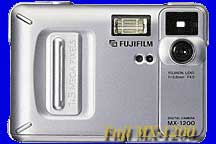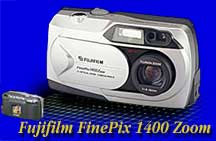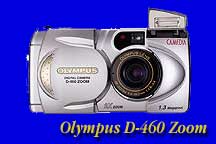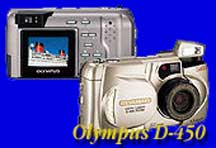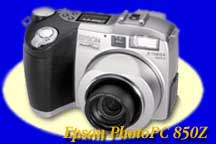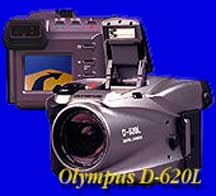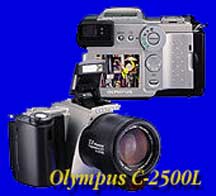| -----So You Want To Buy A Digital Camera! | |||||||||||||||||||||||||||||||||||||||||||||||||||||||||||||||||||||||||
 |
|||||||||||||||||||||||||||||||||||||||||||||||||||||||||||||||||||||||||
| FTLComm - Tisdale - August 12, 2000 | |||||||||||||||||||||||||||||||||||||||||||||||||||||||||||||||||||||||||
|
cameras have been a part |
Since my first box Kodak my folks gave me for Christmas when I was sixteen or seventeen cameras have been a part of my life. 620, 126, 135 cartridge, sixteen millimetre, Polaroids, Single Reflex Lens, fixed thrity-fives, Super-8; a long succession of film cameras took the boxes and boxes of pictures that are part of family history and at various times were part of our Kelso Photography company and The Watson Lake Gateway newspaper. During our newspaper days it was seven three foot long rolls of thirty-five mil Tri-X or Ilford every week processed in our own darkroom. In 1986 we boxed up the darkroom where it remains until this day. | ||||||||||||||||||||||||||||||||||||||||||||||||||||||||||||||||||||||||
|
capturing |
Not that I stopped taking pictures but at that time the realisation was that it was time to move away from film.we equipped our Apple //e with a "Computer Eyes" video card and began capturing video images on that eight bit primative computer and shortly there after moved on to a //GS with only modest improvement. But with a Macintosh LC in the house and a Video Spigot we were routinely capturing video images for use in documents and making use of our video camera as the main family picture taking device. | ||||||||||||||||||||||||||||||||||||||||||||||||||||||||||||||||||||||||
|
higher resolution |
When Apple introduced the 660AV I had one of the first ones in Saskatchewan as it had a built in video capturing capability and set up my school's student data base with each student's picture. Created hockey programmes with video images and recognised that though video was workable a higher resolution was needed. | ||||||||||||||||||||||||||||||||||||||||||||||||||||||||||||||||||||||||
|
digital still cameras |
I was hardly alone in this quest because electronic companies like Casio began churning out low quality digital still cameras and after a couple of years of pretty lousey results, Epson brought out its Photo PC 500 which was a workable camera and provided the images for Ensign up until May of this year. | ||||||||||||||||||||||||||||||||||||||||||||||||||||||||||||||||||||||||
|
next camera |
While I have been plugging away with the Epson PC 500 the industry has been forging ahead with remarkable gains in picture quality and the time has come for people who want to take pictures to consider a digital camera as their next camera. | ||||||||||||||||||||||||||||||||||||||||||||||||||||||||||||||||||||||||
|
the paper |
The main breakthrough in digital photography is not in the cameras, oh they are good
and getting better, but the real progress has been made with dots. Every picture
we see is really just a collection of tiny specs of colour.  The finer the spec the clearer the picture's
definition and more lifelike the image. Epson, Canon,
Hewitt Packard, Lexmark have all been working on making
smaller and smaller accurate specs. Though Hewitt Packard held the
early lead in this technology, it was surpassed by Canon and now Epson
is the clear and decisive leader. Lexmark makes in-expensive printers
that do the job and essentially all of these manufacturers are turning out printers
that make a picture. The key to success is not entirely the printer but is the paper.
Photo quality papers in a high quality inkjet printer turn out photos. The finer the spec the clearer the picture's
definition and more lifelike the image. Epson, Canon,
Hewitt Packard, Lexmark have all been working on making
smaller and smaller accurate specs. Though Hewitt Packard held the
early lead in this technology, it was surpassed by Canon and now Epson
is the clear and decisive leader. Lexmark makes in-expensive printers
that do the job and essentially all of these manufacturers are turning out printers
that make a picture. The key to success is not entirely the printer but is the paper.
Photo quality papers in a high quality inkjet printer turn out photos. |
||||||||||||||||||||||||||||||||||||||||||||||||||||||||||||||||||||||||
|
1,440 dots |
Epsons line of printers from the Stylus 440, 640. 740, 750, 800, 900, 1200, 1500 and 3000 all use a similar method of creating images of an amazing 1,440 dots per inch. Printed on their photo glossy paper or other coated papers you will see images that look like they were turned out by Kodak. Of course, you can purchase Kodak print paper for this purpose. | ||||||||||||||||||||||||||||||||||||||||||||||||||||||||||||||||||||||||
|
photographer |
In every instance the paper is more important than the printer, printer is more important than the camera and the photographer is most important of all. To take good pictures you need to look at Gerald Crawford's work and realise that composition is more important that the thing with which you are using to take the picture. | ||||||||||||||||||||||||||||||||||||||||||||||||||||||||||||||||||||||||
|
harder to |
It wasn't long ago that we all assumed that digital photography would never ever surplant chemical film and though in theory that is true, the camera technology is rapidly taking us to the point were it is getting harder and harder to know the difference. The old PhotoPC 500 I used for so many years produced a 144 dot per inch image that was 640 x 480 pixels in size. So on your computer screen that was a full size image, because no matter what the camera can do, the screen can only display 72 dots per inch. | ||||||||||||||||||||||||||||||||||||||||||||||||||||||||||||||||||||||||
|
mega-pixel image |
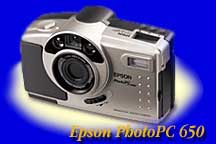 My new bottom of the line entry level Epson PhotoPC 650 produces a mega-pixel image with a resolution of 144 dots per inch which turns out on a computer screen at its 72 dots per inch to be 1152 by 864 pixels. But, keep in mind this is the bottom of the Epson line of cameras selling retail at $449 in most stores. Epson, Fujitsu and Olympus each make cameras with almost three times that resolution for about three times that price. While AGFA is producing consumer cameras that cost less than $200 producing images of the same quality of the Epson PhotoPC 500 (640x480) and of course everything above. |
||||||||||||||||||||||||||||||||||||||||||||||||||||||||||||||||||||||||
|
high |
When you go shopping for a digital camera those four names mentioned will deliver excellent cameras with more features then you need, with quick down load capability that will let you forget the costs of film, film processing and worrying about wasting film on a picture that won't turn out. When you start shooting with a digital camera you will quit taking "safety" shots, that second shot just in case the first one didn't turn out, because the high reliability of the digital camera makes them seem unnecessary. | ||||||||||||||||||||||||||||||||||||||||||||||||||||||||||||||||||||||||
|
Kodak |
There are some camera brands you really have to watch very carefully because they are not good buys. Both Kodak and Sony produce excellent cameras with remarkable features but both are about $200 above the price of equivalent quality cameras, but if you have an extra $200 to spend you will not buy junk because both the Sony and Kodak cameras offer excellent value but perhaps you can get by without those features they provide. | ||||||||||||||||||||||||||||||||||||||||||||||||||||||||||||||||||||||||
|
Superstore |
The other brands to avoid are those cameras that have a name you have never heard of, you will find at Superstore digital cameras by brand names that are simply jobers of some kind. First and foremost, never ever buy electronic equipment from Superstore, their fine print makes any purchase from them almost completely unreturnable and they will offer you completely no support. For a similar reason I would have reservations buying from WalMart or Cosco unless the manufacturer will back the product. | ||||||||||||||||||||||||||||||||||||||||||||||||||||||||||||||||||||||||
|
Sanyo |
I have not mentioned Sanyo, only because I have not had personal experience with their products. However, both they and Samsung have being making some excellent cameras and I have been told that the Sanyo cameras are a good value. | ||||||||||||||||||||||||||||||||||||||||||||||||||||||||||||||||||||||||
|
what about video |
Now in this long discussion you will no doubt be wondering what about video. Well that's a good question. Video is still a viable alternative. ATI makes video capture cards for PC and Mac computers that do the job and there are now digital video cameras on the market by almost all video camera manufacturers. Digital video cameras offer the ability to take video or still images and when you consider the formidable lens capabilities of these cameras you are seeing some remarkable possibilities. However, I recommend against this route for most folks. Its to much trouble. Besides the digital video cameras are all $1,200 to $1,800 and for most folks who just want to take a picture, that is to much to spend. | ||||||||||||||||||||||||||||||||||||||||||||||||||||||||||||||||||||||||
|
never been a better time |
I m ust qualify
this statement though, if you are into doing video, or want to get into it this as
an entirely different field of photography and visual arts, there has never been
a better time to become involved in this area. Apple's
Machintosh computers, iMacs and others that have "Firewire"
can all soak up digital video without a capture card and come with free "iMove"
soft ware that can make you a pro video editor over night. But this is for the hobbyist,
if you take video like most people, it is a video that you fill up with recent things,
you date it and put it on the shelf and start another one. But if you have stills
interdespersed you will want to edit and that is a bunch of fooling around for the
average person and you are better to have a digital camera to do your stills. ust qualify
this statement though, if you are into doing video, or want to get into it this as
an entirely different field of photography and visual arts, there has never been
a better time to become involved in this area. Apple's
Machintosh computers, iMacs and others that have "Firewire"
can all soak up digital video without a capture card and come with free "iMove"
soft ware that can make you a pro video editor over night. But this is for the hobbyist,
if you take video like most people, it is a video that you fill up with recent things,
you date it and put it on the shelf and start another one. But if you have stills
interdespersed you will want to edit and that is a bunch of fooling around for the
average person and you are better to have a digital camera to do your stills. |
||||||||||||||||||||||||||||||||||||||||||||||||||||||||||||||||||||||||
|
simple is best |
The VCRs in our living rooms have taught us all valuable lessons, more complex is not better when it comes to electronic equipment. When you buy a digital camera your purchase was to take pictures not to spend your time at every important juncture in your life trying to figure out how to make the damn thing work. For this reason I do not recommend the zoom cameras, they offer only 3x zoom and it is not worth the added expense, if you need to get closer move, or use your computer after you have captured the picture. | ||||||||||||||||||||||||||||||||||||||||||||||||||||||||||||||||||||||||
|
Price Ranges |
There are about four levels of digital cameras, the lowest price ones are usually older designs with limited resolution and sell for just over a hundred dollars to below $200 with 640 x 480 capabilities. Since these types of cameras are about four years old I would not recommend you purchasing them unless for a child. The entry level cameras range from just under $400 to $600 and all tend to have similar features with 1 megapixel images of 1152 x 864 and LCD viewing backs and most have video output. The mid level cameras with zoom lens tend to sell from $600 to $800 and the upper level semi pro cameras with appeture settings and other film camera features are from $800 to $2,000. Professional cameras start at around $2,000. In the "then some" category below we have only shown you a few good value cameras but this price range is the most populated and most competitive of all. | ||||||||||||||||||||||||||||||||||||||||||||||||||||||||||||||||||||||||
| I have gone through the suppliers and below is what I can offer at FTLComm for pricing on these cameras, you may find them at other suppliers or online. These prices are FOB Tisdale from Faster Than Light Communications. | |||||||||||||||||||||||||||||||||||||||||||||||||||||||||||||||||||||||||
|
|||||||||||||||||||||||||||||||||||||||||||||||||||||||||||||||||||||||||
